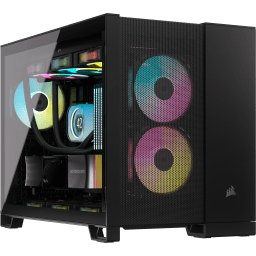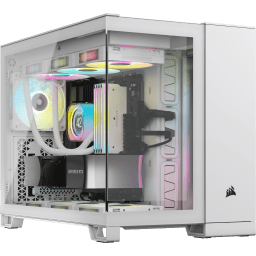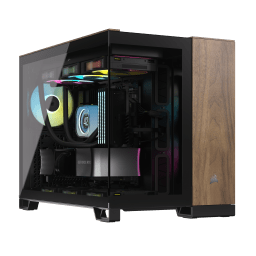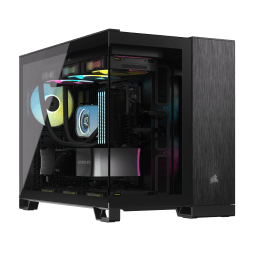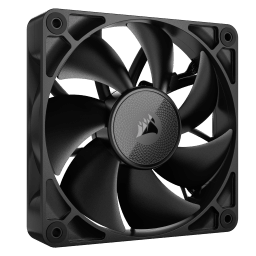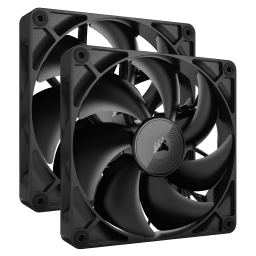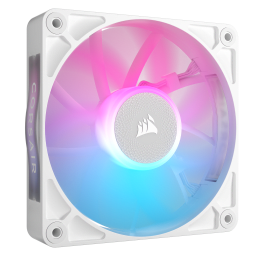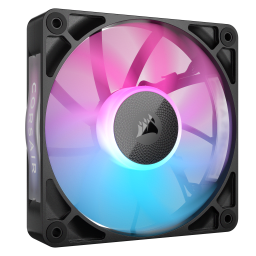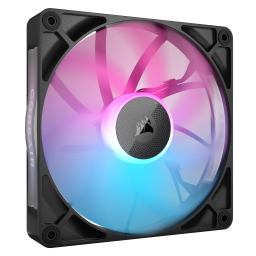BLOG
Best fan configuration for CORSAIR 2500 Series case
When building a new PC, one of the first decisions to make is choosing a suitable PC case. As it is one of the most visible components, a lot of changes have happened over the years to make things more modern. This includes minimalistic designs with more glass and fewer cables and, of course, maximum airflow performance.

There are four common sizes of computer cases: small form factor (SFF), compact mid-tower, mid-tower, and full tower. SFF cases have a reputation for having poor airflow due to their limited internal space. However, if you prioritize performance when designing an SFF case, you can overcome this issue and achieve good airflow.
High airflow in PC cases is not a random occurrence. It is a deliberate design feature that premium case manufacturers engineer into their products. These cases are designed with open spaces, perforated fronts, tops, and sides and use materials that promote heat dissipation. CORSAIR's 2500 Series Case is a prime example of such a case.

The 2500 Series is a high-performance PC case that provides exceptional airflow and cooling. It can accommodate plenty of fans and has versatile radiator mounting options in the front (Airflow only), roof, bottom, and side. In addition, it is compatible with reverse connection motherboards, which offers you a cable-free view of your system. You can route all your cables and mount up to four storage drives in the second chamber for a clean and picture-perfect build.
For a more comprehensive look at the 2500 series case, you can read our main article in which we go into every detail that makes this case genuinely exceptional. For now, though Here's the differences between the versions, and the best fan configurations for the airflow
Different variants of 2500 series case
2000D AIRFLOW
The "D" suffix in 2500D indicates that the design is optimized for airflow, featuring a mesh front and top panel that allows more cool outside air to flow in. This helps your components to operate at their best, improving stability, performance, and lifespan.

2500X
The 2500X variant features a glass front, which offers a sleeker, more stylish appearance without sacrificing much thermal performance.

2500X RGB
The 2500X RGB has the same glass design as the 2500X but with two pre-installed fans on the side powered by an iCUE LINK hub. This case is designed with iCUE LINK cable routing in mind, making it an excellent option for those who want to simplify builds and save time on installation.

What is the best fan configuration for 2500 series case?
Let's briefly discuss why optimal airflow is crucial when building a PC, especially in Small Form Factor cases, before diving into the different fan configurations for the 2500 series case.
Inadequate airflow can have detrimental effects on the performance and longevity of computer components. When the internal temperatures of a computer rise due to poor ventilation, the PC hardware needs to throttle its performance to avoid overheating, leading to a sluggish experience. Exposure to high temperatures over an extended period can also shorten the lifespan of your computer components, which is a nightmare for any PC enthusiast. In the worst-case scenario, insufficient cooling can cause critical components to fail prematurely.
Starting with the 2500D AIRFLOW model, using 120mm fans, let's get to the core of this article.
2000D AIRFLOW Best fan setup
Fan and Radiator Support:
Fan: Front: 2x 120mm; 2x 140mm / Top: 3x 120mm, 2x 140mm / Side: 2x 120mm / Bottom: 3x 120mm, 2x 140mm / Rear: 1x 120mm.
Radiator: 120mm: Rear / 240mm: Front, Top, Side, Bottom / 280mm: Front, Top, Bottom / 360mm: Top, Bottom

The 2500D AIRFLOW variant can accommodate up to 11 120mm fans, as specified above. To maintain the optimal internal temperature of your system and potentially increase the lifespan of your hardware, it is recommended that you set up your fans in a specific manner. First, make sure that all the bottom, front, and side fans are intake fans, which means they pull fresh air from outside the case and direct it toward the hot components in your build. Secondly, configure your rear and top fans as exhaust fans, which means they remove the hot air generated by your components. This fan setup will help achieve the best internal temperature possible.
2500X & 2500X RGB best fan setup
For these two variants, the recommended fan orientation will also be based on 120mm fans.
Fan and Radiator Support:
Fan: Top: 3x 120mm, 2x 140mm / Side: 2x 120mm / Bottom: 3x 120mm, 2x 140mm / Rear: 1x 120mm.
Radiator: 120mm: Rear / 240mm: Top, Side, Bottom / 280mm: Top, Bottom / 360mm: Top, Bottom

The X and X RGB models can hold up to 9 120mm fans each, which is quite impressive, considering these are SFF cases. For optimal airflow, it is recommended to set the bottom and side fans as intake, while the single 120mm rear fan and top fans should be set as exhaust. By doing this, you can ensure that fresh air is pushed onto the components while the hot air is expelled efficiently through the rear and top of the case. This will help maintain ideal temperatures for your components.
Final Thoughts
When selecting a high-airflow PC case, it's not enough to simply choose the largest one with the most fans. Various factors affect the efficiency of airflow within a case, including the placement and configuration of fans. Additionally, the strategic positioning of dust filtration plays a crucial role in optimizing airflow, which the 2500 series case is designed to provide.

The proper choice and placement of fans play a crucial role in directing the airflow where it is needed, especially in cases that have limited internal space, such as the 2500 series case. However, this can be easily resolved by strategically placing intake and exhaust fans to ensure that there is a sufficient supply of fresh air coming into the case and then expelling the hot air generated by the internal components like the CPU, GPU, and power supply.
To find the ideal PC case for your build, check out CORSAIR's complete case lineup on our website.
A CIKKBEN SZEREPLŐ TERMÉKEK



